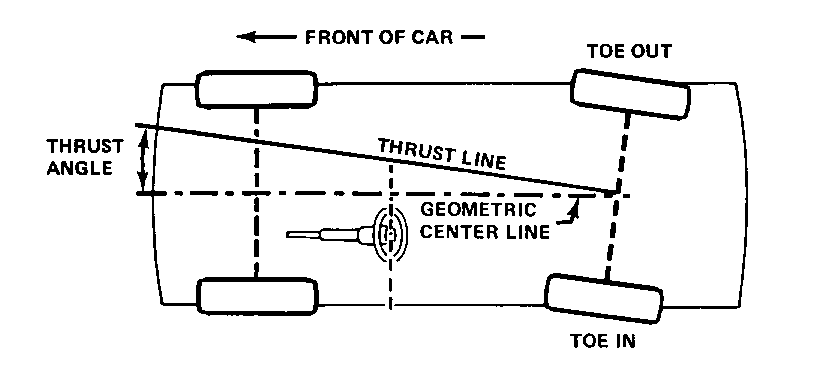SERVICE GUILD: THE IMPORTANCE OF FOUR WHEEL ALIGNMENT/ALL

Models Affected: ALL 1979-89
Consider the diagram in Figure 1. In which direction will the car travel if the steering wheel is straight ahead?
The car will track to the left because of the directional forces created by the rear wheels and tires. This directional force is called the "thrust angle". The front wheels aim or steer the vehicle but the rear wheels control tracking and assist in directing the car.
What might the driver comment about?
In the example shown in Figure 1, the driver may comment about the steering wheel being off center when going straight down the road. This would be true because of the added input required at the steering wheel to offset the thrust angle force caused by the rear wheels not tracking the front wheels to the geometric center line of the vehicle.
The driver may also comment about unusual tire wear, not precise handling characteristics and even decreased fuel economy.
A four wheel alignment allows the technician to measure the toe of each rear wheel to determine if the rear wheels are tracking the geometric center line of the car. Ideally the geometric center line will be the same as the thrust line. In the example in Figure 1, the thrust line has shifted to the right because the rear wheel toe is not tracking the front wheels. This can occur on both or on one rear wheel. On some vehicles such as the Bonneville and Grand Prix, the rear toe is adjustable. Other models may require component straightening or replacement or shims. Once the rear toe is properly adjusted or set, the front wheel toe can be set so all four wheels are tracking the geometric center line of the vehicle. This will provide optimum tire wear, handling and fuel economy characteristics for the vehicle.

General Motors bulletins are intended for use by professional technicians, not a "do-it-yourselfer". They are written to inform those technicians of conditions that may occur on some vehicles, or to provide information that could assist in the proper service of a vehicle. Properly trained technicians have the equipment, tools, safety instructions and know-how to do a job properly and safely. If a condition is described, do not assume that the bulletin applies to your vehicle, or that your vehicle will have that condition. See a General Motors dealer servicing your brand of General Motors vehicle for information on whether your vehicle may benefit from the information.
